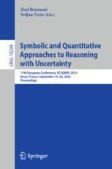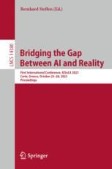Search
Search Results
-

-
Some Remarks About Dependent Type Theory
The goal of this chapter is to describe a calculus designed in 1984/1985. This calculus was obtained by applying the ideas introduced by N.G. de...
-
On Identifiability of BN2A Networks
In this paper, we consider two-layer Bayesian networks. The first layer consists of hidden (unobservable) variables and the second layer consists of...
-
Ends, Means and Functions
The purpose of this chapter is to clarify the distinction between goals and objectives which can be considered as different types of ends....
-
ChatGPT in the Loop: A Natural Language Extension for Domain-Specific Modeling Languages
This paper presents an approach to no-code development based on the interplay of formally defined (graphical) Domain-Specific Languages and informal,...
-
Continuous Engineering for Trustworthy Learning-Enabled Autonomous Systems
Learning-enabled autonomous systems (LEAS) use machine learning (ML) components for essential functions of autonomous operation, such as perception...
-
Benchmarks: Semantic Segmentation Neural Network Verification and Objection Detection Neural Network Verification in Perceptions Tasks of Autonomous Driving
The verification of the security of neural networks is cruicial, especially for the field of autonomous driving. Although there are currently...
-
Welcome Remarks from AISoLA 2023/Track C2 Chairs
We are happy to present the proceedings of AISoLA’s Track C2: Verification meets Learning and Statistics.
-
gRoMA: A Tool for Measuring the Global Robustness of Deep Neural Networks
Deep neural networks (DNNs) are at the forefront of cutting-edge technology, and have been achieving remarkable performance in a variety of complex...
-
Towards a Formal Account on Negative Latency
Low latency communication is a major challenge when humans have to be integrated into cyber physical systems with mixed realities. Recently, the...
-
Shielded Learning for Resilience and Performance Based on Statistical Model Checking in Simulink
Safety, resilience and performance are crucial properties in intelligent hybrid systems, in particular if they are used in critical infrastructures...
-
What, Indeed, is an Achievable Provable Guarantee for Learning-Enabled Safety-Critical Systems
Machine learning has made remarkable advancements, but confidently utilising learning-enabled components in safety-critical domains still poses...
-
Hypergraphs in Logic Programming
Heterogeneous data is a significant topic in today’s context, necessitating the development of AI tools. Logic programming is a powerful approach for...
-
Conditional Objects as Possibilistic Variables
The interpretation of basic conditionals as three-valued objects initiated by de Finetti has been mainly developed and extended by Gilio and...
-
A Logical Framework for User-Feedback Dialogues on Hypotheses in Weighted Abduction
Weighted abduction computes hypotheses that explain input observations. It employs parameters, called weights, to output hypotheses suitable for each...
-
Macsum Aggregation Learning and Missing Values
In recent work, a new kind of aggregation method has been proposed under the name of MacSum aggregation function that can be viewed as an interval...
-
Action Phases
The purpose this chapter is to introduce temporal aspects of actions in more details including a discussion of their relations to causal roles of...
-
Dyadic Transformations
The purpose of this chapter is to use the action types described in Chap. 10 to define basic generic...
-
Technical Artefacts and Humans
The purposes of this chapter are to explain the nature of a technical artefact, and to introduce social-cyber-physical-systems (SCPS) as the...
-
Control Actions
This chapter analyses the functional relations between a control system and the process in a SCPS by applying the dyadic and triadic transformation...
